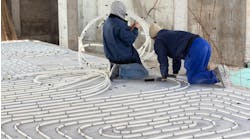Latest from Radiant
eBook: Nelson Mechanical Stories - Volume 1
Sponsored
WARRENSBURG, N.Y. — During his career as an HVAC engineer for highrise buildings and hydroelectric plants, George Weinshenk knew the importance of hiring the right professionals who put quality products into the job. After his retirement, he and his wife, Barbara, turned their attention to building a new home on a 28-acre site on a mountain overlooking Lake George in northeastern New York.
The decision to build a log home came quickly. But it took many months of careful planning and the rigorous interviewing of dozens of contractors and suppliers before they were ready to break ground for the 9,000-sq.-ft. house. George Weinshenk scrutinized all facets of the process, from foundation and back-up power generation.
Comfort, indoor air quality and plumbing were high on the list to receive special attention. For these needs, the Weinshenks chose David T. Sellers Mechanical Contracting, based in Warrensburg, to design and install the systems.
Dave Sellers has been doing radiant installations since 1989 when he installed radiant heat — practically on a dare — in the garage/ workshop of a former employer.
Weinshenk's decision to go with radiant was based on hearing about its comfort and efficiency, Sellers said.
"He had never lived with radiant," Sellers said, "but he had had enough people tell him about it. That's what I'm finding with this market. It tends to be a fairly educated consumer.
"Fortunately, we're the only firm in the area that's really into radiant, and certainly the only Radiant Panel Association member and RPA-certified designer and installer. We do mostly high-end new construction work, so this job was a good fit."
Sellers became an RPA member shortly after the organization was founded in 1994. He took RPA's designer and installer certification exams about two years ago, he said, adding that being certified has been a useful marketing tool to promote his radiant business.
"My only disappointment with the job was that the Weinshenks were passionate about radiant heating before I could start the fire," Sellers said with a smile. "Typically, the homeowners that we work for are knowledgeable about radiant, and interested in it, but not entirely certain that it's the right choice. Actually, I couldn't design a better stage. It's only a short time into my presentation that they see my passion for radiant, grasp of the technology and expertise . . . and then I get to sell the romance of it. Works (almost) every time."
The $100,000 for the mechanicals pays for: air filtration; two Lennox heat recovery ventilators; Lennox high-efficiency, variable-speed air conditioning units; Watts Regulator advanced mixing valves for the plumbing system; tekmar digital controls; two Munchkin boilers with outdoor reset controls; a Super Stor indirect water heater; Kitec PEX-aluminum-PEX tubing for the home runs from the remote manifolds to the boilers; copper tubing for the plumbing; and Watts Radiant Onix synthetic polymer tubing for the floor heating.
The size of the home and its mountaintop exposure to winter storms made the Weinshenk project different from Sellers' typical jobs. "With a design temperature of minus 20F, we took a few extra precautions when building the Weinshenks' system," Sellers said. "The house has 11 zones of heating, including eight radiant and three high-temperature zones, plus the indirect-fired water heater. We also installed two separate cooling systems, each with two stage compressors, variable-speed blowers and three zones each. The air filtration is top of the line and includes germicidal UV lights in the air stream. Add to that two large heat recovery ventilators, and we have a very healthy and comfortable whole-house system."
Weinshenk added: "We wanted a lot of tile flooring, so radiant was the perfect way to warm otherwise cold and uncomfortable surfaces. And, in the largest room of the house, it was the perfect solution."
The Weinshenks' great room — a 48-by-28-ft. space with a ceiling peak of 24 ft. — was exposed on three sides, including a center wall with many large windows.
"The great room is perfectly suited for entertaining and family gatherings," Weinshenk noted. "And it holds its heat well, even in the dead of winter with the winds going full tilt. Dave solved the need for extra heat along the exterior walls by adding an extra pass of tubing; the technique worked well."
Being a cautious man, Weinshenk wanted an "insurance policy" on his radiant heat system. He specified that electric resistance strip heaters be placed in the air conditioning ductwork throughout the house.
"It was for my peace of mind," he said. "But we didn't need them at all. I couldn't say to Dave, 'I told you so!'"
Another of Weinshenk's precautions was the purchase and installation of a 15kw LP gas-powered electrical generator with a V6 engine rated for continuous duty.
"To accommodate it, we added a dedicated 100-amp panel specifically to power essentials within the home during a power outage from the main line," Weinshenk said. "Power is lost up here with some frequency — especially during ice storms or when heavy winds blow branches and trees into the power lines. It's also good to know that the radiant-heated floors act like a thermal storage system, retaining their heat for a long time."
Though radiant heat installations make up 70% of Sellers' work, his approach to home comfort and energy efficiency stems from a systems philosophy that many facets contribute to the overall home environment. As a Building Performance Institute-certified contractor, Sellers said he uses a "whole-house" approach that incorporates comfort, health and safety, durability and energy efficiency into a comprehensive package.
"Buildings are systems of interacting parts," Sellers said. "So our philosophy is to take into account all of the key 'pieces of the puzzle' and to determine how they affect each other, and what we can do to positively influence what's happening."
The whole-house approach led Sellers and the Weinshenks to a mutual decision when the plumbing system was designed.
"With such a large home, George knew that he'd need a hot water recirculating system to guarantee that all domestic water sources would have ready hot water," Sellers said.
Speaking with experience from his years in commercial construction, Weinshenk added: "With hot water recirculation already planned, it was only one additional step to kill the harmful bacteria that invariably grow within the domestic lines. We chose to have Sellers install a whole system and point-of-use, thermostatic balancing valves."
"There's been a dangerous trend lately to reduce the temperature of hot water within domestic water systems," Sellers said. "By lowering water temperatures, legionella and other toxic bacteria multiply quickly, threatening all who come in contact with it.
"Yet, if water temperatures are set at higher levels to kill the bacteria, the risk of scalding increases."
Sellers chose to install advanced combination point-of-use under-sink and shower valves (or type T/P) — a hybrid of both pressure balancing and thermostatic performance requirements. He added one main T/P valve in the mechanical room to govern the whole house.
T/P valves protect the homeowner because they allow hot water to be distributed at higher temperatures throughout the plumbing system.

